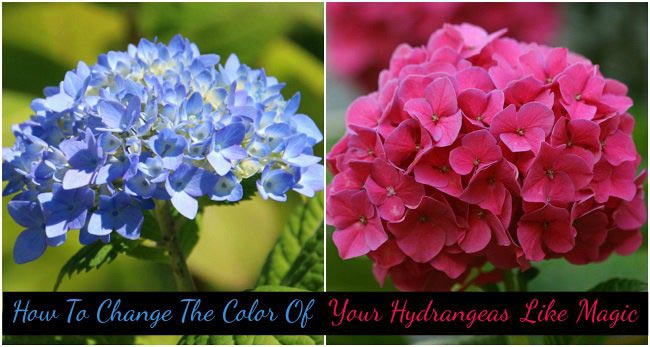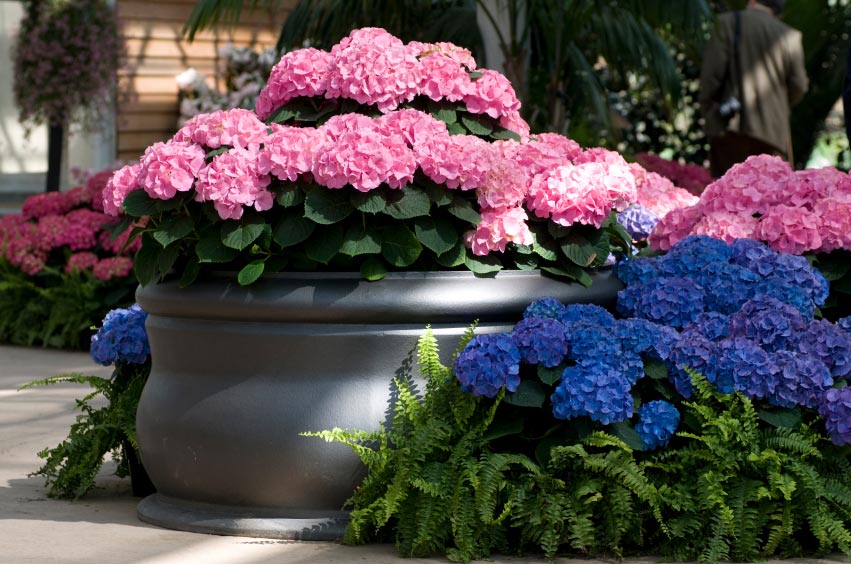
Love gardening? Then you’ll love our brand new Kindle book: 605 Secrets For A Beautiful, Bountiful Organic Garden: Insider Secrets From A Gardening Superstar.
Hydrangeas, the popular garden shrub with delicate flowers in pinks, whites and blues, is more fascinating than it first appears.
Why?
Because the blossoms on this beautiful plant have the ability to dramatically change color.
Maybe you’ve already noticed a perplexing color change in your own shrubs and couldn’t figure out the reason.
Well, the secret behind their chameleon-like qualities is pretty simple – it’s down to the pH of the soil.
And, now you know that, the ability to change hydrangeas to suit your garden is well within your control. It’s no more difficult than a school science experiment, although it does require a little more dedication and patience.
If you grow your hydrangeas in containers or want to change from pink to blue, you’ll have it a little easier than those who want to switch from blue to pink. Naturally, container gardening means you have much more control over the pH and condition of your soil.
However, if you have white or cream hydrangeas, sorry – you’re stuck with them, their color can’t usually be altered. If you’re lucky, at the end of the season you might see a little pink tinge but that’s about it.
Changing Hydrangeas from Pink to Blue

If you’d like your hydrangeas to take on that beautiful, shimmery violet-blue color they’re known for, then you’ll need to make your soil more acidic. This enables the aluminum in the soil to be released to your flowers, helping them take on a blue hue.
Firstly, check the pH of your soil to see how easy it will be to lower to the required level – you’ll be looking at a pH of around 5.2 to 5.5 for blue blooms.
If your soil’s pH is pretty high, you might be better off accepting your pretty pink blooms. Otherwise, you can acidify the soil by adding certain substances to it. While there are special products on the market that lower pH, a natural way is always best … even if it does require a little more time.
Using an organic mulch will help acidify the soil, and is also quite beneficial for microbial life and improving the quality of your soil. Try one made of pine bark, pine needles, sawdust, citrus peels, vegetable peels or coffee grounds. It’s a great way to get rid of kitchen waste too.
If you’re seeing no results the following year, you may also need to add some aluminum to the soil- you can buy products to help you do this.
Changing Hydrangeas from Blue to Pink
Changing from blue to pink means you’ll need to stop aluminum in the soil from being available to the hydrangeas. By all accounts, this is a little more difficult than going from pink to blue, but it can be done! You’ll need to raise the pH level to prevent the roots taking up the aluminum. Aim for a pH of about 6.0 to 6.2.
While conventional methods recommend using lime to slowly raise the pH over a few months, natural options like ground crab or oyster shells, crushed eggshells or hardwood ashes are also very effective.
What Exactly Do I Do?
- Work these natural products into the soil at the base of the plant quite regularly to affect pH change.
- Test the pH of your water too – even this could be enough to throw off the delicate balance you’re working so hard to achieve.
- Make sure to monitor the pH of your soil over time to see if your efforts are paying off.
- Be patient – you won’t see a change in color until the following year.
Other Things to Know
- While you may be able to change the color of the flowers, you may not have so much luck changing the intensity of that color. This can often be down to heredity factors and weather conditions.
- Some soil can just be too alkaline or too acidic to change naturally. Don’t get frustrated if the color change doesn’t happen. You could also plant a few in containers as you’ll have much more control over their soil pH levels.
- Planting hydrangeas near concrete can make it difficult to get blue blooms – the lime can leach out of the concrete, affecting the soil’s pH.
So that’s it – the simple secret behind changing the color of your hydrangeas. Good luck!
